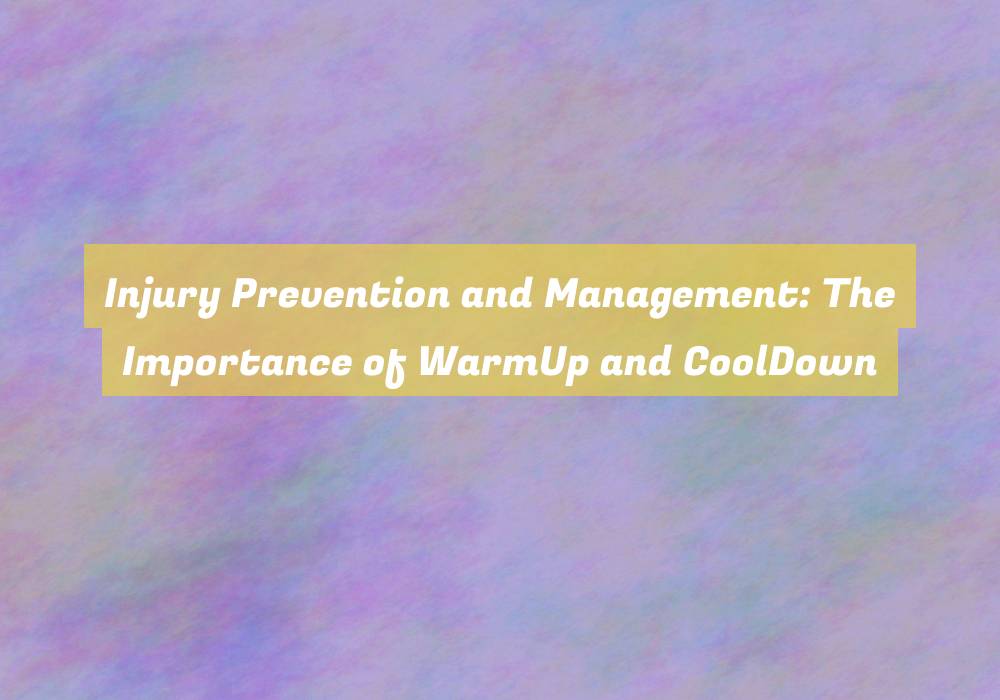Injury Prevention and Management: The Importance of WarmUp and CoolDown
You know that feeling when youG??re about to take a long road trip, and you realize you forgot to check the oil and tire pressure? ItG??s a bit like that when it comes to exercise G?? skipping your warm-up and cool-down is like neglecting to prepare your body for the journey ahead.
But why is it so crucial? Well, letG??s just say that the impact goes beyond simply preventing muscle soreness. ThereG??s a whole world of physiological benefits to discover, and itG??s all within your reach.
Benefits of Warm-Up Exercises
To maximize the benefits of warm-up exercises, itG??s essential to engage in dynamic movements that actively prepare your body for the upcoming activity. Dynamic stretches, such as leg swings, arm circles, and lunges, help increase your heart rate, improve blood flow to your muscles, and enhance joint flexibility. These movements also mentally prepare you for the workout ahead, allowing you to focus on the task at hand.
Engaging in warm-up exercises primes your nervous system for action, improving coordination and reaction time. It also reduces the risk of injury by gradually increasing the intensity of physical activity, allowing your muscles, tendons, and ligaments to adapt to the upcoming demands.
Additionally, warm-up exercises help enhance your overall performance during the main activity by increasing muscle efficiency and power output.
Effective Warm-Up Techniques
Engage your body in dynamic movements to effectively prepare for physical activity during your warm-up routine. Start with light cardio exercises such as jogging or jumping jacks to increase your heart rate and blood flow to your muscles. Incorporate dynamic stretches like leg swings, arm circles, and hip rotations to improve flexibility and range of motion.
Perform sport-specific movements such as high knees for runners or shoulder rotations for swimmers to mimic the actions youG??ll be doing during your main activity. Include some bodyweight exercises like squats, lunges, and push-ups to activate and strengthen the major muscle groups youG??ll be using.
Gradually increase the intensity of your movements to gradually raise your body temperature and mentally prepare for the upcoming workout. Aim for a total warm-up duration of 10-15 minutes, ensuring that you break a light sweat by the end.
Importance of Cool-Down Routine
After completing your physical activity, itG??s essential to prioritize a proper cool-down routine to facilitate the gradual recovery of your body. Engaging in a cool-down routine helps to gradually lower your heart rate and blood pressure, preventing dizziness or fainting that can occur when you stop exercising abruptly. It also aids in preventing the pooling of blood in your extremities, reducing the risk of lightheadedness and potential complications. Additionally, a cool-down routine allows for the dissipation of waste products, such as lactic acid, from your muscles, which can help minimize muscle soreness and stiffness post-exercise.
Moreover, incorporating a cool-down routine can contribute to the overall improvement of your flexibility. As your body temperature gradually decreases during the cool-down, it becomes an opportune time to perform static stretching exercises. This can aid in maintaining and enhancing your range of motion, which is crucial for injury prevention and long-term athletic performance.
Cool-Down Best Practices
As you wrap up your physical activity, prioritizing a proper cool-down routine not only aids in the gradual recovery of your body but also plays a crucial role in preventing post-exercise complications and enhancing your overall flexibility.
To effectively cool down, begin by reducing the intensity of your activity for at least 5-10 minutes. This could involve brisk walking or gentle stretching exercises. ItG??s important to focus on the major muscle groups that were involved in your workout, holding each stretch for 15-30 seconds to help relax the muscles.
Additionally, incorporating deep breathing and relaxation techniques during your cool-down can help lower your heart rate and promote a sense of calm. Hydration is also key during this phase, as it supports the bodyG??s recovery process. Remember to replenish fluids lost during your workout to aid in muscle recovery and reduce the risk of cramping.
Conclusion
In conclusion, itG??s crucial to prioritize warm-up and cool-down exercises in your fitness routine.
Not only do they help prevent injuries, but they also improve your overall performance.
By taking the time to properly warm up and cool down, you can ensure that your body is adequately prepared for exercise and able to recover effectively afterward.
DonG??t skip these important steps in your workout regimen for a healthier and safer fitness experience.






